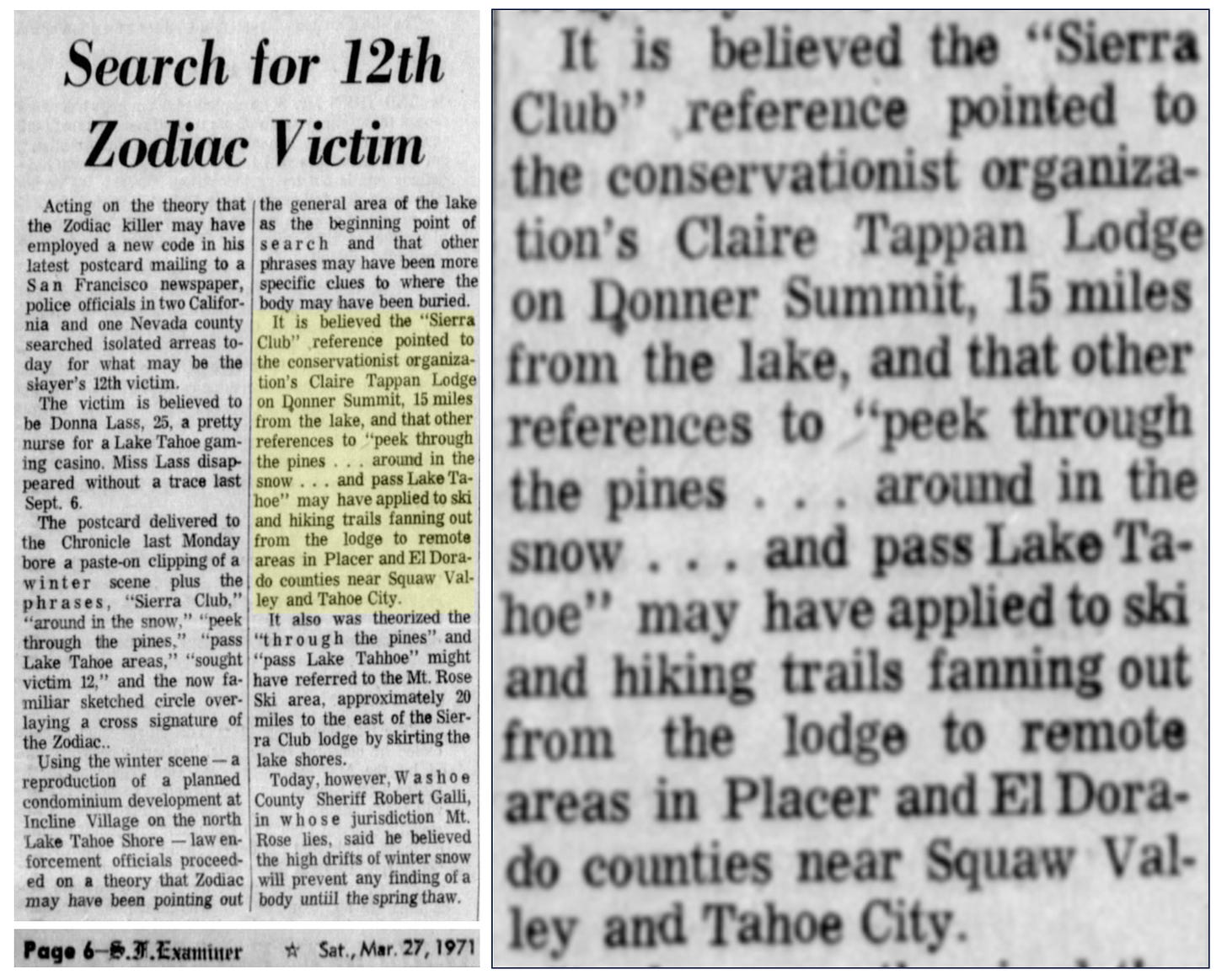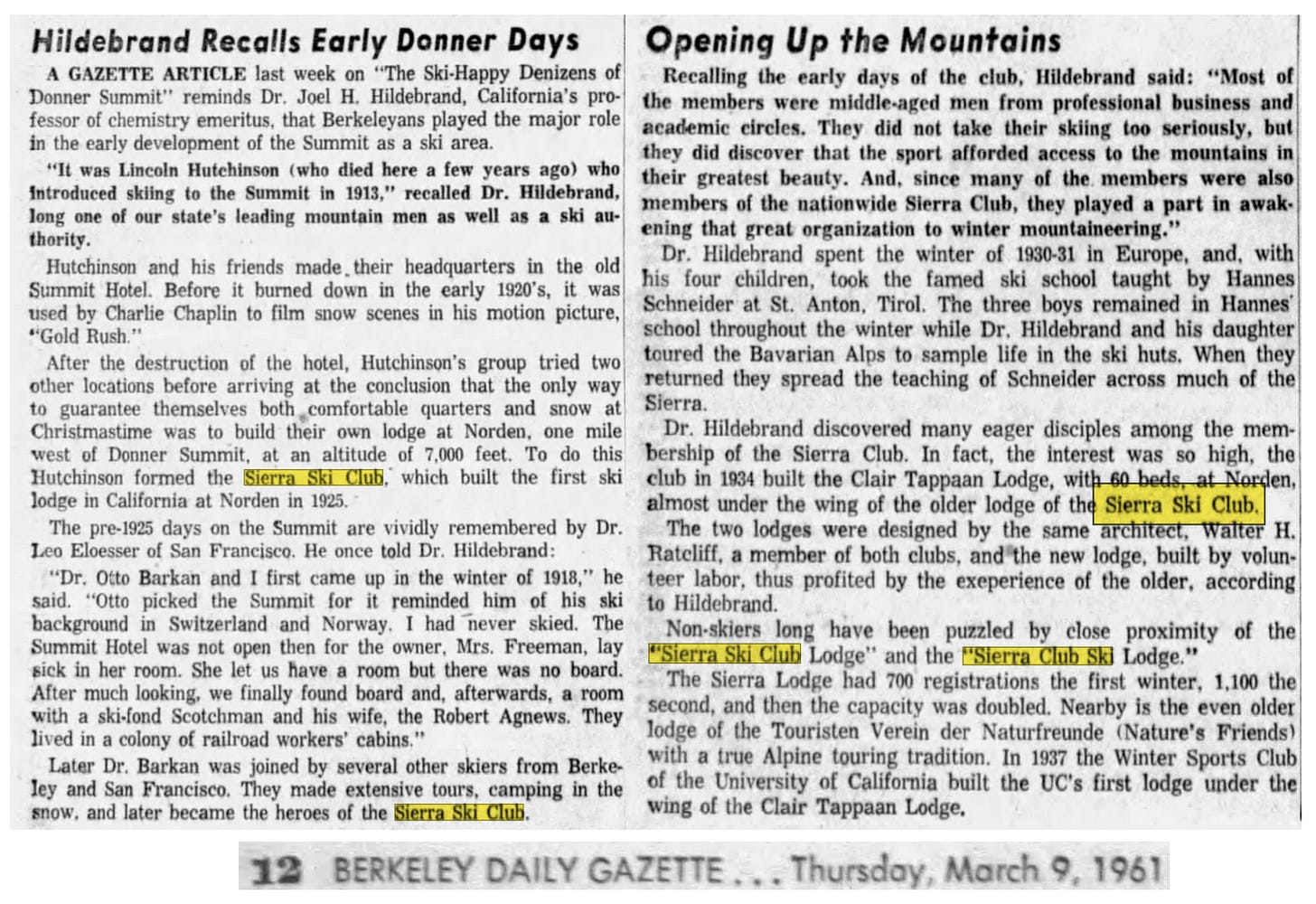Around in the Snow [Part XV]
Eye of the Beholder
Now for a direct comparison of the relative merits of the two interpretations of the Pines Card that I have lately discussed:
“Sierra Club” stands for the Sierra Nevada, go south on Sierra Highway.
“Sierra Club” stands for the Clair Tappaan Lodge, go west on Interstate 80.
Both theories share the postulate that the Incline Village ad art has been repurposed as a large-scale, topological map. On this view, Incline Village as a place is irrelevant to solving the puzzle and finding the “buried treasure.” In other words, the eagle eye of the Zodiac has noticed something in the “ready-made” artwork which lends itself to his purpose — just as he would notice a stray phrase in a thematically irrelevant newspaper article when concocting paste-up text. (On that point, I note that many of the original sources for Zodiac’s cut-up phrases have been identified and there never seems to be any particular significance to the source material.)
If the artwork-as-map idea is correct, we might ask, why did Zodiac select imagery with a Tahoe association (Incline Village), rather than choosing from the much larger pool of ready-made imagery without any such a connection? A reasonable answer is that without the link the “move” of interpreting the imagery symbolically as a kind of map would be too obvious. It’s a red herring. The paste-up text hints tell us explicitly that Tahoe is involved in the solution, and makes it tempting to assume a solution is offered to the “Tahoe Mystery” of Donna Lass, but Incline Village itself is incidental.
We see a row of buildings with inclined roofs, with the label “Sierra Club” affixed. We see a pathway that goes diagonally across the picture, running by those buildings and between the pine trees. At one end of this path we have a punch hole, corresponding to a defaced Zodiac symbol — perhaps a waypoint symbol — on the obverse of the card. At the other end of the path we see an open area with sideways-branching paths, human figures carrying skis, and one figure bent over digging with a shovel.
If the drawing is some kind of map, then we need at least one landmark to relate its features to the real world. The most obvious “way in” is to guess the significance of “Sierra Club.” Early on in the police investigation someone made a guess that this label equated buildings in the scene to the Clair Tappaan Lodge. This is a hostel built and owned by the Sierra Club, located west of Lake Tahoe along the I-80 corridor.
The 1971 San Francisco Examiner story above highlights a difficulty with the ex post facto theory that the Pines Cards legitimately tipped the location of Donna Lass’s remains west of the Clair Tappan Lodge on the I-80 corridor. Even if we run with the idea that the Incline Village scene is being used as a large-scale map and that the “Sierra Club” label signifies the Clair Tappaan Lodge, it’s not clear that this tells us very much. That was a problem back in 1971. The Examiner article mentions that investigators believed that the hypothesized Clair Tappaan Lodge linkage might point towards a grave site in Placer Counter or in Eldorado County. In other words, they didn’t find the link very helpful to channeling their inquiries.
The Clair Tappaan Lodge and the adjacent Sierra Ski Club (now the Hutchinson Lodge) are situated on the north side of Donner Pass Road. That road runs almost parallel to I-80 and about a mile south of the interstate in this area. On the face of it, it would be equally legitimate to equate the trail “through the pines” in the snowscape drawing to Donner Pass Road or to Interstate 80.
If we respect the topology and guess that the punch hole locates the “buried treasure” in this puzzle, then the Donner Pass Road guess guides us eastbound, i.e., the wrong direction. If we stay with Donner Pass Road but guess the hole represents the Tahoe waypoint and the digging man represents the grave (as in my Sierra Highway theory), we are pointed west, which is correct, but as best I can determine the road does not extend to the area where Lass’s remains were found.
If we assume the path represents the I-80 then we get a directionally correct solution if we take the punch hole as representing the grave and ignore the digging man, or a topologically invalid solution placing the lodge north of the freeway if we take the punch hole as the Tahoe waypoint. The bottom line is that “west of the lodge on I-80” fits with the original Clair Tappaan Lodge guess, but it seems that other apparently equally justified but incorrect solutions can also be deduced from the same postulate. So, unless we can identify an additional clue that credibly disambiguates the situation, I think we should be skeptical of the notion that the Clair Tappaan Lodge guess is supported by the find of Lass’s remains far west on the I-80.
Adding to the problem, on the map theory of the Incline Village drawing we get some topological relationships but no scale. Thus, even if we guess the direction from the ambiguous “Sierra Club” hint correctly, we have no way of knowing how far along I-80 to proceed.1 Therefore, even if we guess that the Incline Village scene is a map, and guess that “Sierra Club” designates the Clair Tappaan Lodge, and guess that the path leading up to the punch hole is Interstate 80 and not Donner Pass Road, solving the puzzle is basically useless. At most, on this interpretation one could say that the “payload” of the Pines Card is a hint at a claim of authorship of the “Tahoe Mystery,” which would become a little less ambiguous on the condition precedent that Lass’s remains ever came to light and were identified — as has now transpired, over fifty years later.
While one could imagine the Zodiac concocting the Pines Card purely as a taunt — “I know something you don’t and will never guess” — one has to ask, would he be satisfied by that? Is it in character, based on the totality of his communications, or is a larger game afoot? Something cleverer, that entails an element of risk, that offers a gambler’s rush, and reaffirms his intellectual superiority? Ultimately that’s a judgment call, but a puzzle that’s really just a taunt doesn’t cut it in my opinion.
A related question that arises is, if the Pines Card really did encode the idea that Donna Lass’s body would be found west of Clair Tappaan Lodge on the I-80 corridor, does that entail that the Zodiac (or a Zodiac imitator, if you want to include all possibilities) must have been the author of her abduction? After reading up more about the Hakari and Bennallack cases, explicitly linked to the Lass disappearance in contemporary newspaper coverage, I think the answer must be no. Those crimes occurred close to the I-80 even further west than where Lass’s remains were found. The I-80 is presumably by far the highest-trafficked road out of the Tahoe area. The big population centers near the Tahoe resort lie on the I-80 corridor to Sacramento and San Francisco. So, by the same method Poe used to deduce a solution to the Mary Rogers murder — reading the papers and applying logic — Zodiac might simply have offered a best guess at a general solution which happened to be broadly correct.
I have explained why I think the old “Sierra Club=Clair Tappaan Lodge” theory is quite shaky and why the new Lass information doesn’t change that. At the same time, I think my “Sierra Club=Sierra Nevada” theory (i.e., the “Sierra Highway” or “down there” or “lass named Donna” theory) explains more. It dovetails perfectly with the Spellbound dream analysis sequence that seems to be referenced in the October 1970 Halloween Card. In the interpretation which reveals the ski resort murder and the location of the body, the inclined roofs of buildings represent mountains. Here we have a row of them. It explains why Zodiac cc-ed the Pines Card to the Los Angeles Times — the only time he ever did this. The “payload” of the puzzle on this interpretation seems to me much more Zodiac’s style. If you’re smart enough, and if it doesn’t make you uncomfortable to entertain the idea you’ve been outwitted by Zodiac, that you dropped the ball, fiddled and farted around while he racked up victims, then you might learn something really useful about him, something that would put him in your crosshairs. But he reckons it’s a pretty good gamble that you’ll fail the test — so, another round goes to Zodiac, who “always needs to feel superior.”
I’ve previously stated that I’m confident the Zodiac expected the Pines Card to be seen as a hint about the “Tahoe Mystery” of Donna Lass — that he saw it as a useful red herring to test the intelligence of his audience. That raises the question of whether he thought the Clair Tappaan Lodge connection would be made, and whether it’s another deliberate red herring, like Incline Village. I’ve often thought that the Clair Tappaan Lodge is something George Hodel might have known about. Based on certain details of his biography, it seemed to me that he would be much more likely to know of it than a random person — or a random serial killer — on the street. Digging into the background of the lodge for this piece, that suspicion intensified. For example, I deduce that the Dr. Joel H. Hildebrand in the article below was likely George Hodel’s freshman chemistry professor at Berkeley. I’ll revisit this topic in a future post.
In the wake of the recent Lass news, Richard Grinell did propose that there could be useful distance information hidden in the Pines Card, based on the idea of introducing the scale from the Philips 66 roadmap enclosed with Zodiac’s earlier Mt. Diablo code puzzle and making certain measurements on the card. My impression is that he rightly recognizes the argument is tenuous and is now reluctant to press the case for it further.




